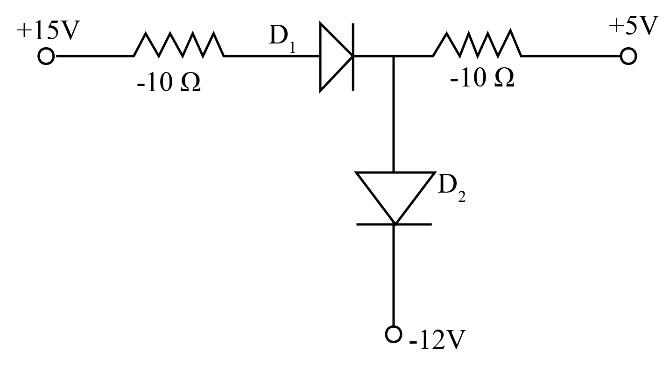
In the above circuit diagram, identify diode (diodes) which is (are) forward biased.

A. Only
B. Only
C. Both
D. Neither

Answer
485.7k+ views
Hint: We will utilise the concept of the flow of current depending upon the voltage, which tells us that current will always flow from the higher value of potential to lower the value of potential. Depending upon the direction of flow of current through the diodes, we will conclude whether they are forward biased or not.
Complete step by step answer:
We know that a diode is formed by the combination of p-type and n-type semiconductor. The triangle represents a p-type semiconductor, and a straight line represents n-type semiconductor in the symbolic representation of a diode.
We also know that current always flows from higher potential to lower potential and it divides when there is a junction in the circuit, depending on the resistance the value of current is divided. From the given circuit, we can see that
Based on the above explanation, we can say that current will enter through the p-type semiconductor and leaves through n-type semiconductor of the diode
Therefore, we can conclude that both diodes
Note:
When a higher potential is connected with a p-type semiconductor, and a lower potential is connected with an n-type semiconductor in a p-n junction then this p-n junction is termed as the diode and connected is called forward biased.
Complete step by step answer:
We know that a diode is formed by the combination of p-type and n-type semiconductor. The triangle represents a p-type semiconductor, and a straight line represents n-type semiconductor in the symbolic representation of a diode.
We also know that current always flows from higher potential to lower potential and it divides when there is a junction in the circuit, depending on the resistance the value of current is divided. From the given circuit, we can see that
Based on the above explanation, we can say that current will enter through the p-type semiconductor and leaves through n-type semiconductor of the diode
Therefore, we can conclude that both diodes
Note:
When a higher potential is connected with a p-type semiconductor, and a lower potential is connected with an n-type semiconductor in a p-n junction then this p-n junction is termed as the diode and connected is called forward biased.
Recently Updated Pages
Master Class 9 General Knowledge: Engaging Questions & Answers for Success

Master Class 9 English: Engaging Questions & Answers for Success

Master Class 9 Science: Engaging Questions & Answers for Success

Master Class 9 Social Science: Engaging Questions & Answers for Success

Master Class 9 Maths: Engaging Questions & Answers for Success

Class 9 Question and Answer - Your Ultimate Solutions Guide

Trending doubts
Give 10 examples of unisexual and bisexual flowers

Draw a labelled sketch of the human eye class 12 physics CBSE

Differentiate between homogeneous and heterogeneous class 12 chemistry CBSE

Differentiate between insitu conservation and exsitu class 12 biology CBSE

What are the major means of transport Explain each class 12 social science CBSE

Draw a diagram of a flower and name the parts class 12 biology ICSE




